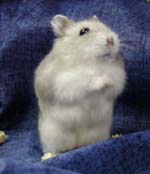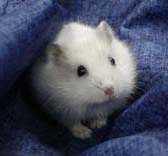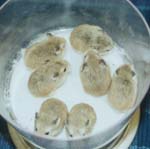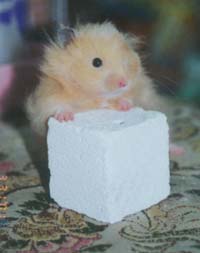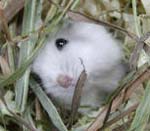HAMSTER
 Am I the right pet for you?
Am I the right pet for you?
Hamsters make good family pets. They need very little space, are easy to look
after and, provided they have ample food and water, can be left on their own for
several days. With plenty of time and attention they can become quite tame.
Hamsters belong to the rodent family.
They are nocturnal creatures and therefore like to hide in burrows, amidst a
vast network of tunnels during the day but will come out to play in the evening.
Their average life span is between two to three years. Due to their small size
and general requirements hamster are ideally suited to children and adults.
 Where did I come from?
Where did I come from?
There are no less than 27 species and sub species of hamsters found across
different countries and habitats. The majority live within semi-desert areas,
however, not all are kept as pets. The most common is the Golden or Syrian
hamster. Other smaller species include the Dwarf Winter White Russian, the
Chinese hamster and Roborovski hamster.
More recently other breeds have appeared from different parts of the world, for
example, the Chinese Striped hamster. Syrian hamsters were first introduced
during the 19th century however, it wasn't introduced into the pet market until
the 1950's.
 Where did I like to live?
Where did I like to live?
Hamsters need lots of exercise, so buy the biggest cage you can afford,
preferably at least 62cm x 46cm x 35 cm. Plastic cages with metal tops are best
as wooden ones will be gnawed and splinters can damage the hamster's pouch. With
modern world there is more variety or brands of cages that provide lots of
interest and fun for pet and owner and you can add to them to accommodate
additional hamsters. The floor of the cage should be covered with wood shaving
for bedding. An enclosed 'house' is important as a refuge and allows your pet to
feel secure when he is asleep.
Wooden toys for chewing and gnawing treats should always be available. Hamsters
will divide their accommodation up into sleeping, eating, bathroom and play
areas. Hamsters like to exercise daily and if provided with a wheel and/or a
ball they can run the equivalent of 4 - 8 miles in an evening!
 How to handle me ?
How to handle me ?
When you first get your hamster home, leave him alone for the first day or two
to get used to his new surroundings. After that it is important to handle
regularly to build up a relationship, but remember hamsters have very poor
vision. First of all talk to him and let him get used to your voice. Then
introduce your hand so that he can become used to your smell. Finally pick him
up very gently by cupping one hand under him and one over him.
Young children should be supervised when handling hamsters and must take great
care not to drop them. Eventually he should come to you and eat out of your
hand.
It is advisable to clean the hamster's cage daily or at least once every 3 days
with hot water and a pet safe disinfectant. Normally a hamster will use one area
of his cage as a toilet, you may use a hamster toilet in this area.
Never let your hamsters out of his cage unsupervised and remember he likes to
chew things, so keep him away from electric cables!
 Keeping me fit and healthy
Keeping me fit and healthy
Hamsters normally stay healthy throughout their short lives. However, there are
a number of common complaints, most of which can be avoided by looking after
them correctly.
If your hamster's coat appears ruffled loses his appetite, coughs and sneezes
and has a nasal discharge, he probably has a cold. Keep him warm and if symptoms
persist take him to the vet. Hamsters can catch colds from humans so avoid
handling if you have one.
Colds can be avoided by keeping the cage out of draughts and the temperature
between 18 - 22c. In cold weather put more bedding in the cage. If your hamster
becomes too cold he may go into hibernation and will need to be warmed up in
your hands to wake him up.
Hamsters are susceptible to severe diarrhea known as Wet Tail which should be
treated immediately by a vet. The cage should then be thoroughly cleaned with
disinfectant. Wet Tail can be caused by rotten or moldy food or bedding or by
stress from too much handling particularly with a new hamster.
Your hamster may suffer a mild form of diarrhea from too much fruit or
vegetables and too many dry pellets can cause constipation. In both cases an
adjustment to the diet is required.
Your hamster's teeth will grow constantly and if they get too long he may be
unable to chew properly. Hamster treats and a mineral stone will help him wear
his teeth down.
It is important not to feed too much sunflower seed. As it is too rich in oil
and this may lead to health problems like tumor and skin problems.
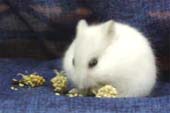
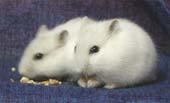
 Do I like company?
Do I like company?
Well looked after hamsters are quite happy living on their own and it is probably best to keep Syrian hamsters alone. Females can become quite aggressive at certain times of the breeding cycle and males will almost certainly fight. If you want to keep more than one hamster it is probably better to keep two female Russian dwarfs.
 What do I like to eat?
What do I like to eat?
Hamsters in the wild are omnivores and will eat a wide variety of food. However,
a dry hamster mix or pellets will provide all the minerals, vitamins and
nutrients required and are clean and hygienic. Hamsters will hoard their food
and therefore fresh fruit, carrot, lettuce or cabbage should be fed by hand so
that you know it has been eaten and not hoarded away where it can rot. Vitamin
supplements can be added to the diet once a week and mineral blocks and chew
treats are usually popular. Pet shop sells snacks and treats for hamsters which
can be used sparingly to liven up the diet and to help tame your hamster.
Food bowls should be sturdy and hard to tip over, as the hamsters will climb
into them. They should be gnaw-proof and easy to clean. Remove uneaten food and
wash food bowl daily and wash out the water bottle and drinking tube regularly.
 Breeding
Breeding
■ Hamsters tends to breed very easily
■ Females may be able to breed as early as 4 or 6 weeks of age depending upon
the species (but should be at least 12 weeks old)
■ Pregnancy lasts about 16 to 18 days
■ Hamsters will have an average litter of 2 to 8, however this can vary
■ The young hamster's eyes will open after 10 - 15 days (2 weeks)
■ Young should not be separated from their mother until they are at least 4
weeks old
■ They are fully grown by 3 months.
